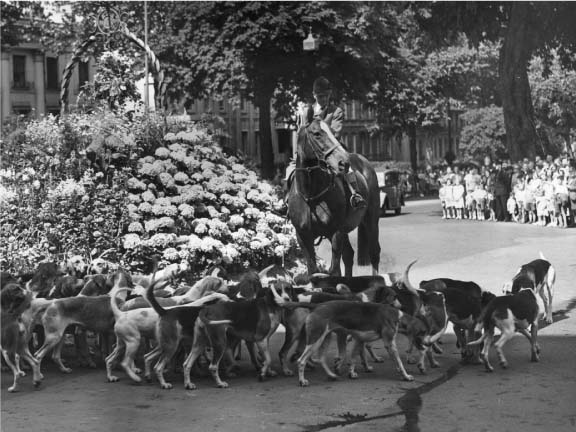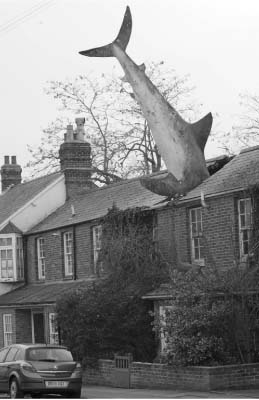Lyttelton's Britain (7 page)
Read Lyttelton's Britain Online
Authors: Iain Pattinson

C
ANTERBURY
is an historic cathedral city and weekend residence of the Archbishop, who at other times lives at Lambeth Palace. Archbishops have for centuries made annual pilgrimages on foot all the way from South London to Canterbury, all the while singing ‘Onward Christian Soldiers’, ‘Jerusalem’ and of course, the piece written specially for the journey ‘Doing the Lambeth Walk, Oi!’
Canterbury has been the inspiration for many works of literature. The best known must be the tales of Chaucer’s pilgrims, but of course T. S. Elliot was also stirred by the tragic story of the death of Thomas à Becket to write his
Old Possum’s Book of Practical Cathedral Murders
.
Historians have recently established that ‘Thomas à Becket’ was actually simply called ‘Thomas Becket’ and that his night-club on West Street was in fact simply called the ‘Whisky Go Go’.
With its Marlowe Theatre and Marlowe Exhibition, Canterbury will always also be connected with the mysterious Marlowe, though quite why Raymond Chandler should have based his LA gum shoe private detective stories in South East England is even more of a mystery.
Canterbury is set deep in the Kentish rolling green country-side, for centuries referred to as the ‘Garden of England’.
However, with the new direct rail link to Brussels from nearby Ashford, Kent has become known as the ‘Patio of Belgium’.
The carving of the Eurostar link through the country’s rich agricultural land was the cause of much controversy at the time, but now with the benefit of hindsight, we are beginning to see the undoubted benefits of rail links with the continent. Parisians can now hail a taxi in the Champs-Elysées or the Rue Montmartre to the Gard du Nord at 11am, speed their way effortlessly at 130 mph through the tunnel before noon, and by two o’clock be stuck at a points failure just outside Orpington.

R
OYAL
T
UNBRIDGE
W
ELLS
is a splendid Regency town in the county of Kent. Although Kent was the first part of England to be colonised by the Romans, they never settled in Tunbridge Wells, having been frightened off by the local tribes’ fearsome house prices.
The area suffered a decline in the 16th Century, when a weak and vulnerable populace was cruelly exploited at the hands of a number of landed families. There were the Knatchbulls of Mersham and the Sackvilles of Knole, but things worsened still with the arrival of the notorious Allders of Croydon.
Tunbridge Wells proper was founded in 1606 when natural springs were discovered nearby and the town’s mattress industry began.
During the 17th Century, the town began to welcome the well-heeled, due to the absence of shoe-repair shops. Many arrived to take the restorative mineral waters, and even King Charles I came to Tunbridge Wells hoping to cure his chronic dandruff, a problem that was eventually solved by major surgery. Shortly after, Royal Appointment was awarded to his regular brand of shampoo, which was specially renamed ‘And Shoulders’.
The elegance of the spa years lives on in the area known as ‘The Pantiles’, a colonnaded walkway named after the pavement of clay tiles. After her son slipped and fell there, Queen Anne
famously paid for Tunbridge Wells to be provided with stone flags, but since no one could get them up the poles, they ended up on the floor.
1735 saw the arrival in Tunbridge Wells of ‘Beau’ Nash, who appointed himself Master of Ceremonies and formulated some strict rules of etiquette. These included knowing which fork you picked your nose with, and dictated that a gentleman should always take his hat off if a lady walked past the window he was urinating out of.
Rural Kent today is at the forefront of the support of countryside pursuits, a tradition that stretches back to the memorable occasion when the Archbishop of Canterbury was invited by the Reverend Dr Spooner to join the Kentish Hunt.

Small schoolchildren prepare to run, following the ban on fox hunting, 2007
A few miles to the south east, tourists may care to visit Romney Marsh, and discuss the many successful seasons he spent at QPR.
For centuries the main industry around Tunbridge Wells was the production of hops. As a consequence, the countryside is scattered with many oast houses, where Kent’s traditional rural crafts are still practised, such as tarting them up and flogging them off for three quarters of a million quid.
On the outskirts of Tunbridge Wells are the interesting sand-stone formations known as ‘Toad Rock’ and ‘High Rocks’, which are used to train mountaineers. A young Ranulph Fiennes came to Tunbridge Wells to practise and went on to make his first attempt on Annapurna, while her husband was working nights.
Other famous names associated with Tunbridge Wells include William ‘Makepeace’ Thackeray and Oswald ‘Let’s Start a War’ Mosley. It was while living in the town that Thackeray wrote and published
Vanity Fair
, and then, later,
Woman’s Own
and
Motorcycle Monthly
.

B
RIGHTON
is a city boasting a rich culture and history. A settlement is first recorded in Brighton as long ago as 3000
BC
, when Celtic Druids practised their ancient worship of oaks, mistletoe and virgins, and indeed oaks and mistletoe are still plentiful in Brighton.
Another ancient settlement was recorded nearby by the Romans, who noted the area for its Neolithic Camp, a style later replaced by the Anglo-Saxon Mince.
In Saxon times, the village developed into a small port, known as ‘Bright Thelmstone’; ‘Bright’ being the Saxon word for ‘Shiny’ and ‘Thelmstone’ meaning ‘Thelmstone’.
Brighton is now a bustling resort, but the numbers visiting only really started to grow in the 1760s, when Doctor Richard Russell claimed that drinking Brighton’s seawater would cure ailments such as asthma, rickets and impotence. This came as good news to the Prime Minister William Pitt, or as he was affectionately known, ‘Wheezy, Bandy, Floppy Willy’.
The town boomed thanks to fishing, and Brighton became famous for its sardines and pilchards. It is recorded that when King Ethelred visited in 975, he was presented with the key to the city, which promptly broke off in his hand.
Brighton first became famous during the English Civil War. With his father executed, Prince Charles fled to Brighton, awaiting
a ship to France. Seeking an inn to take refuge, he was offered the King’s Head. Later, regulations were imposed on street souvenir vendors to prevent them selling body parts.
Much of the southern town had to be reconstructed following the disastrous sea floods of 1705, and this is commemorated in place names such as ‘High Tide Alley’, ‘Basking Shark Blocking the Chimney Street’ and ‘Where’s my Snorkle? (I Need to Use the Outside Toilet) Lane’. Although ‘Where’s my Snorkle? (I Need to Use the Outside Toilet)’ was a quite common expression in 18th Century Brighton, even before the floods.
At the end of the 18th Century, Brighton became fashionable thanks to the patronage of the Prince Regent. As many homes in the Old Town were demolished to make space for the Royal Pavilion, the Prince ordered his soldiers to build a new road for the displaced. A competition was held amongst them to choose a name for the new road, and it was duly named ‘New Road’. Second place went to ‘Tell Him Where to Stick his New Road Street’.
In the 1780s the Prince Regent began to spend heavily on drink and womanising, to the deep dismay of his wife, Caroline of Brunswick. Parliament soon passed an act to prevent the Prince of Wales wasting public funds on frippery and adultery, one which has been studiously ignored by every heir to the throne ever since.
When Queen Victoria came to the throne, the Pavilion became her favourite holiday home. However, in 1841, the London to Brighton Railway was built close by, and she ordered that whenever she was in residence, trains should stop outside the town until she left. Perhaps someone should tell Network Rail she’s not still there.
It was in Victorian times that the writer Lewis Carroll regularly visited his sister in Brighton. He was inspired by watching his niece at play to write both
Alice’s Adventures in Wonderland
, and
Alice’s Adventures Doing Cartwheels for Uncle Lewis
.
It wasn’t until the advent of cheap rail travel that Londoners began to flock to the city in their thousands, when Brighton became known as ‘London by the Sea’, much in the same way as nearby Eastbourne became known as ‘Kick the Bucket by the Sea’.
Brighton was heavily bombed during World War II, but Adolf Hitler ordered that the Royal Pavilion should be left intact, as he intended to use it as a base following a successful invasion. Hitler held a particular affinity for the building, as it only had one ballroom.
Brighton’s first modern shopping centre was built in the 1960s. Called ‘Churchill Square’, it was named in memory of the great wartime leader, and was modelled on his concrete bunker.

Brighton still shows evidence of the disastrous sea floods
Brighton’s cultural heritage is well known, and never was the elegant seaside town more in the cultural spotlight than when it was immortalised unmistakably in Graham Greene’s novel
Our Man in Havana
.
Proud of its heritage, Brighton City Council has taken to
naming its buses after local landmarks and people, such as the Boxer, Chris Eubank, the Devil’s Dyke, Julie Burchill and a nice couple from Hove: Mr and Mrs Notinservice.
Other famous Brighton residents include Jordan and husband Peter Andre. Rumours abound that their marriage is in fact a sham, and the paparazzi are constantly trying to get photos of the pretend pair falling out.
Anita Roddick opened her first business in Brighton during the early 70s. She offered such alternative delights as ‘jojoba and sesame oil’, ‘tea-tree bark with nettle extract’, ‘seaweed and willow-sap tincture’, plus over thirty varieties of Brazilian tree frog creams. However, after six months the restaurant folded, and she went into skin care products instead.
Chris Eubank lives near Brighton in part of a converted monastery. He is often seen driving his famous truck, but ran into trouble recently when he was stopped by the police. By the time he’d finished giving his address – ‘Sixty-seven, Cistercian House, Sheepshank Street, Shoreham, West Sussex’ – he’d inadvertently drowned two traffic cops.